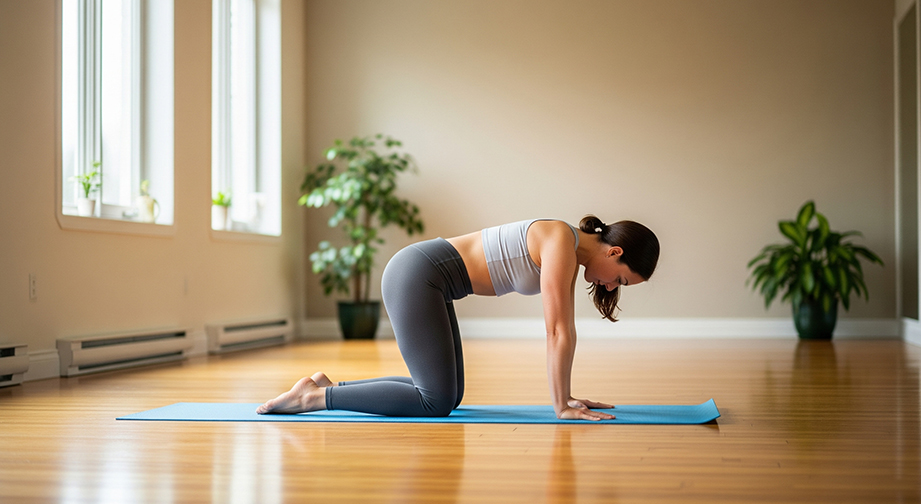Bidalasana / Marjariasana (Cat - Kneeling): How to Practice, Benefits & More
Introduction
Bidalasana, also known as Marjariasana or the Cat Pose (Kneeling), is a gentle yoga asana that imitates the graceful stretching of a cat. The Sanskrit words ‘Bidala’ and ‘Marjari’ both mean ‘cat’, while ‘asana’ means ‘pose’ or ‘posture’. The essence of this yoga position is soothing and balancing – it’s perfect for relaxing the spine and releasing tension.
If you’ve ever felt stiff after sitting too long or need a quick way to relieve neck and back tightness, Bidalasana is your best friend!
Step-by-Step Guide to Bidalasana (Cat Pose)

- Start on your hands and knees.
Place your wrists under your shoulders and your knees directly beneath your hips. Spread your fingers wide for support.
- Align your spine in a “tabletop” position.
Keep your back flat, head in line with your neck, and look down.
- Inhale deeply: As you breathe in, gently lift your head and tailbone towards the ceiling, arching your lower back (this is technically the “Cow Pose,” often paired with Cat for a mini-flow).
- Exhale slowly: Draw your chin toward your chest, rounding your back upwards, tucking your tailbone, and gently pressing the floor away. Feel the stretch along your spine.
- Move with your breath:
- Inhale: Return to arching your back.
- Exhale: Round your spine again into Cat Pose.
- Repeat for 5-10 rounds, matching your movements to your breath (about 1 minute).
- Beginners: Place a folded blanket under knees for comfort.
- Want more? Hold the rounded Cat Pose for 2-3 breaths before cycling again.
- Advanced: Try “hovering Cat” – lift your knees an inch off the floor as you round through your spine for an extra challenge.
Alignment & Safety Tips for Marjariasana
- Keep shoulders stacked over wrists and hips over knees.
- Spread fingers and press down through palms for joint stability.
- Engage your core gently as you round your back.
- Common mistakes:
- Letting elbows bend outwards or sinking into shoulders – keep arms strong and straight.
- Forgetting to use breath – move slowly and steadily.
- Safety precautions:
- If you have knee, wrist, or shoulder injuries, skip or modify (see below).
- If pregnant beyond the first trimester, consult your doctor or use extra padding/support.
Benefits of Bidalasana (Cat Pose)
Physical Benefits
- Improves spinal flexibility and mobility.
- Gently strengthens the core muscles and shoulders.
- Helps correct posture by bringing awareness to spine alignment.
- Eases tension in the back, hips, and neck.
Mental Benefits
- Relieves stress and calms the mind.
- Promotes mindfulness and awareness of breath.
- Encourages gentle movement to release mental stagnation.
Energy/Chakra Connection
- Stimulates the Muladhara (root) and Svadisthana (sacral) chakras for grounding and flow.
- Unblocks and balances energetic pathways along the spine.
Contraindications: When to Avoid Cat Pose
- Recent or chronic back, wrist, or shoulder injuries.
- Severe knee pain or inflammation.
- Pregnancy after first trimester (without doctor’s guidance).
Safe alternatives: Try a seated cat-cow movement, or practice gentle spinal rotations in a chair.
Beginner’s Tips & Variations
- Props: Place a folded blanket under your knees or wrists for extra cushioning. If wrists are sensitive, come onto your fists or rest forearms on blocks.
- Gentle variations: Move slower and keep your range of motion small. Focus on gentle breath and relaxation.
- Advanced variations: Try “Thread the Needle” from tabletop between cat-cow rounds for deeper shoulder stretch, or transition into “Downward Dog” from hands and knees when ready.
How to Include Bidalasana in Your Yoga Flow
Marjariasana (Cat Pose) is ideal as a warm-up for the spine at the start of any yoga session. It can also be used as a gentle transition or cool-down.
Great to pair with:
- Bitilasana (Cow Pose)
- Balasana (Child’s Pose)
- Adho Mukha Svanasana (Downward-Facing Dog)
Mind-Body Connection
As you flow through Bidalasana, bring attention to the movement of your spine and rhythm of your breath. Let this posture be a moving meditation – each inhale and exhale guides your body, calming your busy mind.
Emotionally and spiritually, Cat Pose connects you to your foundation (root chakra), offering a sense of security, and unlocks creative energy through the sacral chakra. Picture yourself moving with ease and grace, just like a cat!
Summary Box: Bidalasana / Marjariasana (Cat - Kneeling)
- Asana Name: Cat Pose (Bidalasana / Marjariasana)
- Level: Beginner
- Focus Areas: Spine, Core, Shoulders, Hips
- Duration: 1–2 minutes, 5–10 rounds with breath
- Best Time to Practice: Morning or anytime your body feels stiff
FAQs about Bidalasana / Marjariasana
Is Bidalasana (Cat Pose) safe for everyone?
Most people can practice Cat Pose safely, but take caution if you have severe wrist, knee, or back injuries. Use support or try chair adaptations as needed.
How often should I do Marjariasana?
Even a daily practice is safe and beneficial. Use it as part of your regular warm-up or anytime your back needs relief from stiffness.
What should I feel in Cat Pose?
You’ll feel a gentle stretch along your spine, with mild engagement in your core and shoulders. There should be no pain or sharp discomfort.
Can I do this pose during pregnancy?
Yes, but with caution after the first trimester. Keep movements gentle, widen knees for space, and use props for support.